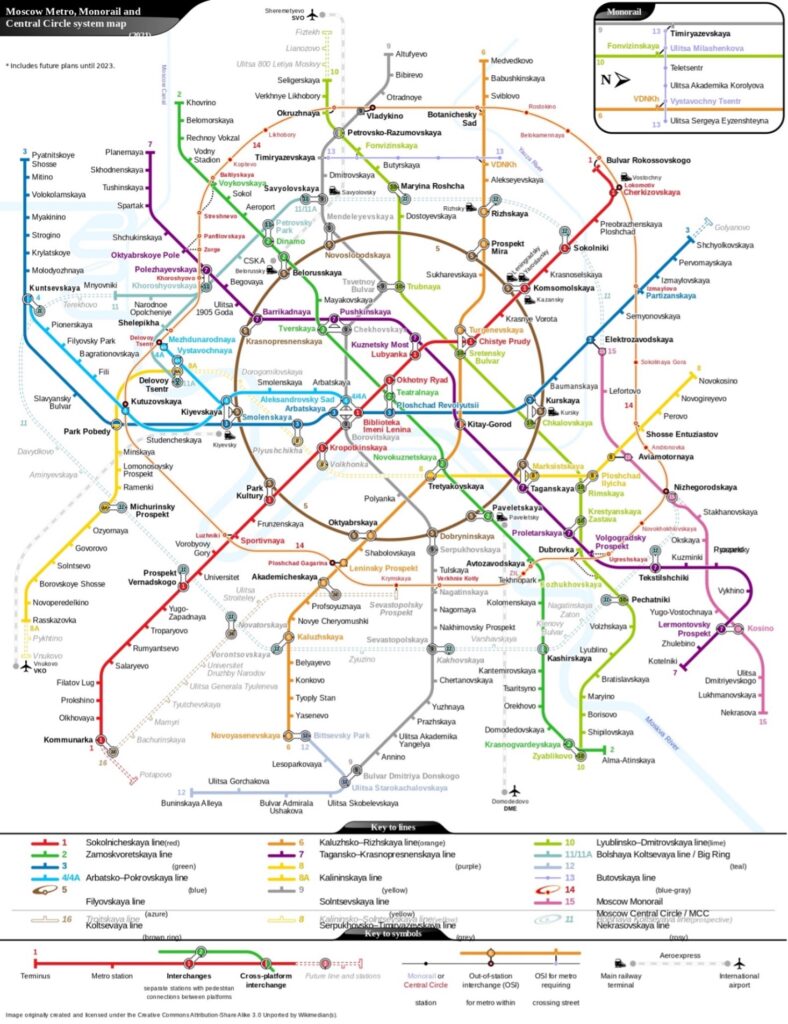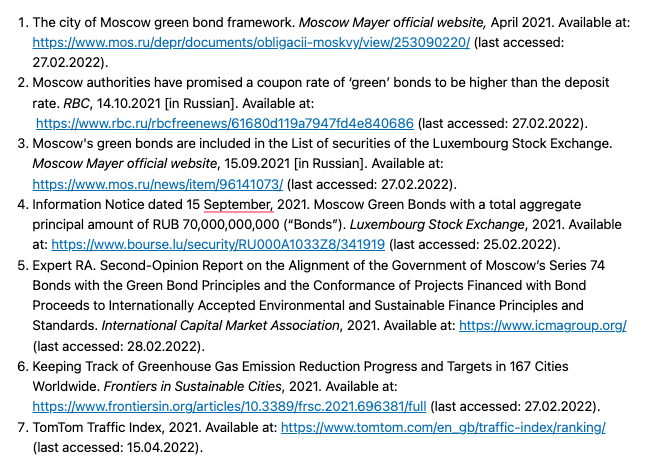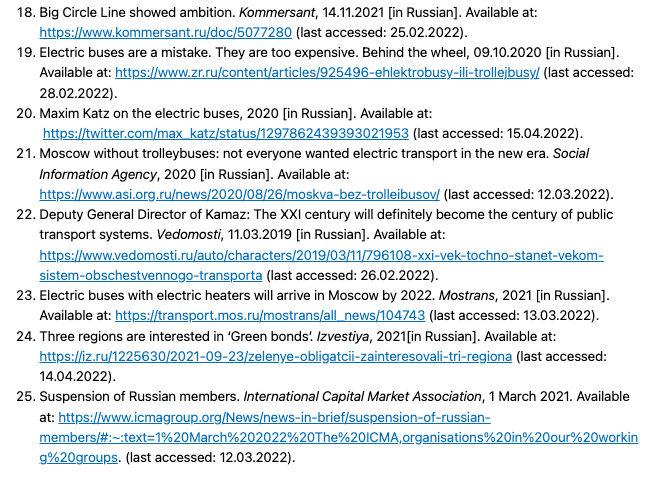Occupy Goes Global!
Moscow
In 2020 OCC! expanded its scope and encouraged students to explore local initiatives in their city, resulting in entries from various locations. Here below you find the entries from Moscow
Scroll for more
In 2020 OCC! expanded its scope and encouraged students to explore local initiatives in their city, resulting in entries from various locations. Here below you find the entries from Moscow
Scroll for more
Anna Kryukova
The green bonds initiative
In April 2021, the Moscow government adopted a new concept of the city’s green bonds. All the funds received from their placement were supposed to be spent on construction of the new metro stations and purchase of electric buses [1] [2]. The bonds worth 70 billion rubles were issued by the city government on the Moscow Exchange in May 2021 and later in September were presented on the list of securities of the Luxembourg Stock Exchange [3]. The issue was carried out in accordance with the Green Bond Principles (GBP) of the International Capital Market Association that also confirmed that the project met Sustainable Development Goals (SDGs) [4] [5]. Thus, it became a part of international sustainable finance community.
In this entry, I explore the specifics and possible impacts of this initiative and challenges that it faces. In particular, I reflect on the project’s engagement with climate change, its objectives, values, feasibility, and limits.
Moscow’s background
In this section, I briefly outline the environmental issues that city faces, as they have determined the features of the green bonds initiative. Moscow’s 2021 population was 12,6 million people. It is the largest Russian city with developed industry, services, and urban infrastructure. Accordingly, the emission issues are relevant. Moscow is one of the worst polluters among the world cities: annually it emits more than 110 million tons of CO2 equivalent into the atmosphere [6]. Although the main source of emissions in Moscow is the energy sector, the popularity of cars powered by internal combustion engine also worsens the situation, additionally affecting air quality and contributing to heavy traffic. Several ratings on the traffic situation in the world cities contain very different data and results, however, according to TomTom traffic index, as of 2021, the Moscow region has taken the second place in the traffic index with congestion level of 61% [7]. According to INRIX 2021 Global Traffic Scorecard, Moscow is the 4th most congested city in the world with 108 hours lost in congestion annually [8].
Environmental, climate, and social relevance of the initiative
The Moscow administration considers the initiative to be a part of city’s efforts to achieve the following Sustainable Development Goals: Goal 11 (Sustainable Cities and Communities) and Goal 13 (Climate Action) [9]. This project is one of the city’s tools to reduce GHG emissions by 30% by 2030, improve air quality and thus public health. As the project is completed, Moscow has to become a healthier and more accessible place to live in.
Although the main reason for issuing the bonds is directly to addresses climate change, the project also greatly affects the city’s infrastructure and improves mobility. According to the mayor Sergey Sobyanin, the metro will become more accessible for ~800 thousand of Moscow residents. Travel time from one area to another will be reduced approximately by 20 percent, so all the residents using metro will benefit at some point [10]. The administration experts claim that more than thirteen thousand people will switch from personal cars to public transport when Bolshaya Koltsevaya line (also known as Big Circle Line) is completed. Moreover, some areas around the new stations are planned to be landscaped and arranged with greenery, so that local residents get a chance to have a better rest outside. This measure will contribute to climate adaptation as well, as the heat waves are relevant for Moscow. The total zone of such improvements should make up to approximately 44 hectares. Also the local government plans to construct bicycle parking stations near the metro, so the residents who use bikes as a transportation source, will also benefit [11]. It is not clear, whether such improvements will be done only with funds collected under the green bonds, however, these projects are interconnected at any rate.
According to officials, the proposed transport infrastructure will lead to the following greenhouse gas emissions reduction: carbon dioxide by 20,900 tons per year, and other pollutants by 885,5 tons per year (starting from 2023). For illustration, CO2 emissions from one diesel bus and one electric bus are estimated at 64.9 and 4.4 t / year on average, respectively [12]. Replacing just one diesel bus with an electric one allows to reduce the air pollutant emissions by 190-260 kg per year [13].
The initiative has one more impact that is not so obvious and that is related to citizens’ financial literacy. The administration is willing to involve the residents in financing the city’s green projects and thus increase their financial awareness. In late 2021, the representatives of local government claimed that the bonds exclusively for private investors were going to be issued. However, it is unclear for the author at this point if such initiative has been fulfilled yet.

Implementation status and challenges
Now I outline the progress that has already been made and criticism that the initiative faces.
Maturity date for the Moscow green bonds is May 18, 2028. The low-carbon transport project will be completed by the end of 2023, and it is not clear at the moment what kind of measures will be taken after that. As for now, the authorities have already made a particular progress, for instance, ten metro stations were opened in December 2021 [14]. In general, the Big Circle Line has to be completed by the end of 2023 [15] with 18 new stations built and 3 stations reconstructed. About 48 kilometers of the metro lines are going to be built or reconstructed.

According to the plan, the electric buses have to be purchased in 2021-2023. In total, the administration plans to buy approximately 1675 of them on the funds collected from the green bonds issue. As of November 2021, 800 electric buses have already been purchased. The Moscow city government plans to procure another 500 in 2022 [16].

The bonds turned out to be quite popular: demand exceeded supply by 1.2 times. The authorities have stated that the citizens in particular showed a high demand for green bonds. They have already invested about 700 million rubles in the project – that is the main reason for the local government to issue the bonds for individual investors [17].
Despite the existing success of the project and its ambitious goals, it is still being criticized. I have outlined three groups of disaffection:
A critical reflection and a future of the initiative
As the Moscow administration claims, the authorities of other Russian regions and cities have already expressed their interest in issuing their own green bonds, for instance, Saint Petersburg, Moscow Oblast,[1] and Krasnodar Krai [24]. It is a very important fact for the environmental protection, but I see even a greater potential in this. The power of regions in Russia is limited by many issues. Moscow’s attempt to take action in tackling climate change could encourage other regions not only to become more ambitious non-state actors in the global climate regime, but also to truly strengthen the federalism in the country. However, I had made such a suggestion before the war against Ukraine began. Now the Russian people face the mobilization times: free speech and anti-war movement are being prosecuted, unprecedented sanctions make the federal government limit both green agenda (many federal programs are being postponed) and regions’ opportunities to decide their development directions.
As of March 2022, due to Russian’s invasion of Ukraine and the sanctions imposed, the Moscow bonds were suspended from the Luxembourg Stock Exchange. Also the International Capital Market Association (ICMA), being an influential center for sustainable development initiative, suspended all Russian members [25]. With no doubt, the project of Moscow administration and the green agenda in general will be greatly affected in Russia from now on.
The project has the following joint co-organizers (investment banks engaged in Bond issuance): Alfa Bank, BCS Global Markets, VTB Capital, Gazprombank, Credit Bank of Moscow, Otkritie Bank, Promsvyazbank, Raiffeizenbank, Rosbank, Region Broker, Russian Agricultural Bank, Sber CIB, Sovkombank. Due to the war, the sanctions were imposed on many of them. Moreover, the foreign investors probably will not be interested in Russian state bonds in the nearest future, even the green ones. The author doubts that domestic investors will be able to cover the whole project now, although at the very beginning the Moscow administration expected the demand of Russian investors to be sufficient.
Despite all this, I consider the green bonds to be an effective instrument that could boost the changes and contribute to climate change mitigation and adaptation. The financial mechanisms have a great potential of accelerating the voluntary transformation and raising ambition.
Although the validity of some decisions made in the green bonds project is questionable, for example, the choice of certain models of electric buses, the general approach of promoting green mobility is promising. The initiative does not only improve the environmental state of Moscow, but also takes into account the social part of the transformation related to climate change. Such transition has to be a part of sustainable development in a broader sense. Also, although the decentralization in Russia will obviously be delayed, the accumulated experience and acquired skills can be used in the future. The transformation is still possible.
References



[1] Moscow and Moscow Oblast are different independent regions. While Moscow Oblast has several cities and other kinds of settlements and it’s a standard region according to Russian law, Moscow has a special status, being both a region and city. The same goes to St. Petersburg.